
| This site celebrates the life and work of sculptor John Cassidy (1860 - 1939). |
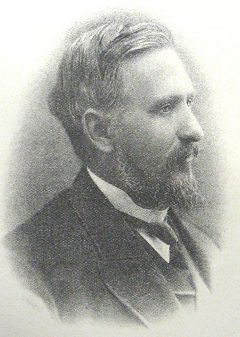
In the basement of the original Manchester station building of the Liverpool and Manchester Railway, now part of the Museum of Science and Industry, there was, until it was taken down in 2015, an exhibition on the theme of 'The Making of Manchester'. In a display case devoted to the Manchester Ship Canal, along with silver casket containing the scroll recording Sir James's Freedom of the City. was John Cassidy's bronze bust of Sir James Wilson Southern, a director of the Canal company. The bust and scroll are now in the Museum's store.
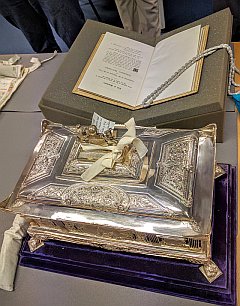
The silver casket and accompanying booklet. The text of the scroll, reproduced in the register of Freemen, is available online as an image.
Although never credited in the display, this is undoubtedly the work by John Cassidy exhibited at the Manchester Academy of Fine Arts exhibition 1909 (no. 266) and included in Cassidy's exhibition at his Lincoln Grove gallery in 1914 (no.55).
Southern's name is not well remembered in Manchester today, but his contribution to the life of the city in his time was of some significance, far wider than just his work for the Ship Canal. On this page we recount just some facets of his life and work.
We have gone into much greater depth of detail about the Southern family than is normal in an article like this, partly because it's very interesting, and partly because we have received a number of emails from his descendants since this was first published, complimenting us on the work, answering questions and giving details.
The bust
The Museum curators inform us that the bust is 'on loan from one of his relatives'; despite uncovering several press cuttings from the time, we can find no mention of its commissioning. It is likely that Cassidy worked from a photograph, perhaps one of those reproduced here.
Some clues as to how Cassidy became involved can be perhaps gleaned from his family story: his third wife, Mary Anne Weild, was the daughter of an engineer, William Weild who had worked at the Sharp Stewart locomotive works in Manchester. One of the witnesses at her wedding to James was Harriette Elizabeth Gresham, the wife of Samuel Gresham. Samuel Gresham's father was James Gresham, who had also worked at Sharp, Stewart, and is much celebrated on our website as one of John Cassidy's most ardent supporters and sponsors. Could he have instigated the production of the bust?
Certainly James Gresham, along with Samuel and Harriette Gresham, attended Sir James's funeral as family friends. It is also likely that he knew Cassidy through his membership of the Manchester Literary Club.
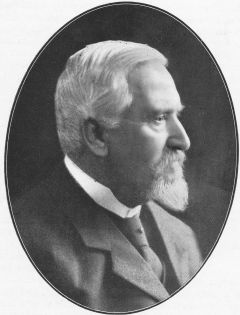
J.W.Southern & Son
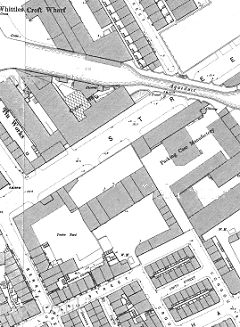
Southern is said to have founded his business in 1860 on Store Street, Manchester near London Road (now Piccadilly) railway station and adjacent to the aqueduct which carries the Ashton Canal over the street. A plan dated 1891 shows the 'Packing Case Manufactuary' and adjacent 'Timber Yard' occupying a significant part of the south-east side of the street.
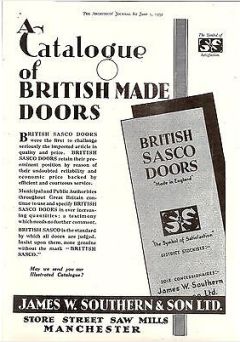
In 1908, soon before the death of James, the Partnership of James Southern and his son Frank was incorporated as a private company, James W. Southern & Son Ltd. The advertisement above dates from 1932.
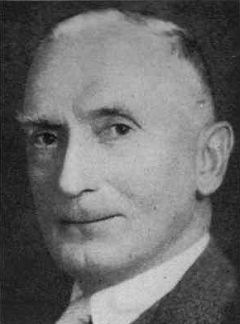
Above: Frank Southern, from a 1938 obituary published in his adopted home village of Disley, Cheshire. He took an active part in the life of the village, serving as a councillor, and served a year as the Chairman of the Council.
In 1933 the name of the firm was changed to 'Southerns Ltd', and a majority interest in the packing-case side of the form was sold to a new company which took on the old name. Southerns, which had been under the Chairmanship of Raymond Henderson Southern (born 1904) since his father Frank's death in 1938, became a public company in 1963. By 1964 the group was trading from 18 branches, mostly in the North and Midlands of England. 32-34 Store Street, Manchester was still in operating, but the firm's headquarters was in Widnes.
In the years following, mergers and takeovers created Evans-Southerns, which in 1975 merged with Yorkshire-based form Magnet to become Magnet & Southerns. The 1980s were troubled times for the joint group, and in 1988 Southern-Evans business was split off again and sold to its management. The Southerns name disappeared from view around 2006 in further takeovers; the business is, we believe, now absorbed into the Howden's Joinery Group.
Southern and Darwent
The name of Southern is still alive in the timber industry in the form of Southern & Darwent, now part of the Travis Perkins group of companies. This firm operated for many years in Collier Street, Knott Mill, Manchester, but is now based in Salford. Its website says it began as Southern & Wheelden in 1887, becoming Southern & Darwent in 1901. This would appear to be a descendant of James's father Lee Southern's original timber firm: James's sister Eliza married George Darwent, and the couple were among the mourners at James's funeral in 1909.
Southern houses
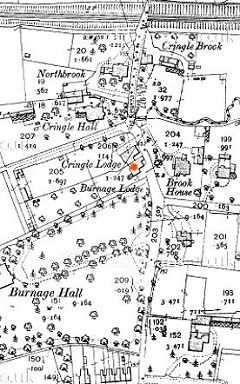
Burnage Lodge, c. 1900. In 2015 a new development of three-bedroom flats stands on the site.The drive of the formed Burnage Hall is now a residential street called Hanlith Mews.
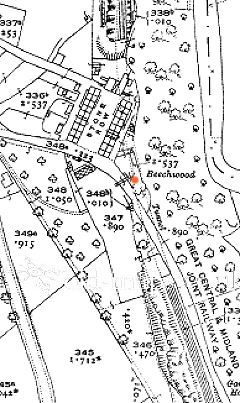
'Beechwood'. After James Southern's death, it became the home of Robert Barker, a cotton spinner, and his family.
The building survives in 2015, converted to apartments and known as 'Beechwood Manor'.
Pankhurst Incident
In October 1905, Alderman Southern became involved in the aftermath of a disturbance which occurred during a Liberal Party meeting in the Free Trade Hall, Manchester. Women's suffrage campaigners Christabel Pankhurst and Annie Kenny were ejected from the hall by police after raising a 'Votes for Women' banner and causing a disturbance. They resisted, and so found themselves arrested and brought before a Magistrate. Southern, who was a friend of Miss Pankhurst's father, attended out of interest, attempted to help the women offer some defence, but when they admitted the charge, nothing more could be done. A fine of 10s 6d for assaulting a police officer was imposed on Miss Pankhurst, which she refused to pay and was sentenced to Strangeways Gaol. Miss Kenny received a three days' sentence. A report in the Manchester Guardian suggested that 'a prominent politician who has interested himself in the case will see that the fines are paid into Court' although it appears that they did serve their full sentences. In a letter to the Manchester Courier, Alderman Southern wrote of 'unnecessary violence by the Police' but commented that 'I could not imagine, nor can I yet, how any intelligent person can suppose that a worthy and just cause can be promoted by conduct - I will not say becoming of a educated lady, but unworthy of any citizen of either sex.' A debate which continues to our own time, perhaps, but arguably the events of that day were the spark which ignited the Suffragette movement.
Sir Edwin Southern
Sir James was not the last member of the Southern family to be honoured with a knighthood. Sir Edwin Southern (b.1938), a prominent figure in the world of DNA analysis, was made a Knight Bachelor in the Queen's 2003 Birthday Honours.
His great-grandfather, James Wilson Southern's brother Moses Wilson Southern (1845 - 1899), became an accountant and ran a laundry, known as Southern and Kinsey, at 70-72 Quay Street, Manchester, and lived at 92 Quay Street. Like his brother, he served on the City Council, as a member for the Quay Street area from 1893, and was known for his active interest in public health matters; he was chairman of the St John's Ward Health Homes Society. He died suddenly after being nominated as candidate for a further term, but before the election; after a delay, it was decided that his opponent Mr Whatmough could claim the seat.
A modern, but georgian-style, row of offices replaced the Quay Street buildings in the 1970s.
References and sources
Census and other records on ancestry.co.uk
Southerns Limited. Share issue prospectus. The Guardian, 19 February 1965, p.20.
Irish poverty and English sympathy: a story of industrial help in Connemara Pamphlets. PDF file, Oireachtas library.
'Miss Pankhurst and the Police', Manchester Guardian, 16 October 1905.
'Miss Pankhurst's Protest'. Manchester Courier, 19 October 1905.
Papers of the Manchester Literary Club, 1909, p.500-504.
'The Late Sir J.W. Southern.' Manchester Guardian, 14 January 1909. p.4.
Obituary: Frank Southern. Manchester Guardian. 4 January 1938, p.17
'Roll of Honorary Freemen of the City of Manchester' in Manchester Archives. Digitised version online as Flickr album.
About the Browns:
T.Swindells, Manchester Streets and Manchester Men, second series. Manchester: Cornish, 1907. p. 138-140.
Mary Smith, The Wee kirk at Kirkandrews - online blog post
David Waller, The Perfect Man: The Muscular Life and Times of Eugen Sandow, Victorian Strongman. Brighton: Victorian Secrets, 2011.
Council threat to "open house".
The Guardian, Apr 19, 1973, p.5.
Alice Frank, 'A Bowdon Romance'. Cirencester, Memoirs Books, 2012.
Credits
Thanks are due to all the people who who helped with information for this feature, especially James Southern of Cape Town, without whom it would not have been possible.
Gareth Pugh, Corporate and Collections Information Officer of the Museum of Science and Industry for information about the bust, and for facilitating access to it in store.
Judith Simpson of the Kirkandrews Kirk Trustees for information about May Southern.
David Waller for pointing us to his book and other valuable assistance.
Richard Wells for the hand-drawn Family Tree from the family archive.
Jeremy Gould for information about his great-uncle Woodroofe Fletcher.
The staff of Manchester Central Library, especially for helping me find the Manchester Faces and Places volume.
James Wilson Southern (1909)
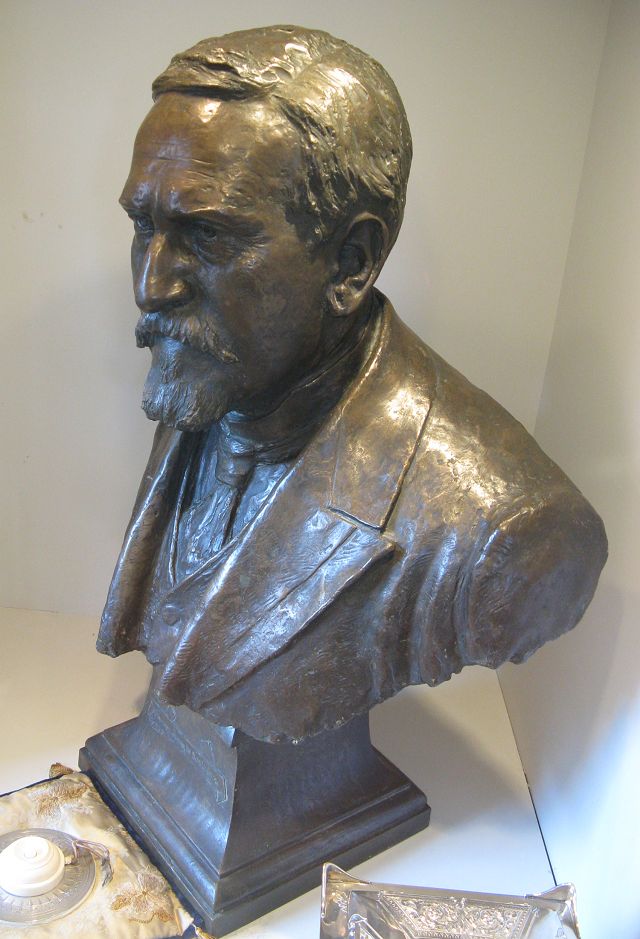
James Wilson Southern was born in Manchester in 1840. He was the son of Lee Southern, born in Lymm, Chester c.1816, who married Eliza Wilson in Manchester in 1836.
In the 1841 census Lee Southern described himself as a 'chest maker' and is listed in an 1853 directory as operating a saw mill in Jackson's Row, off Deansgate in central Manchester. By 1861 Lee Southern was listed as 'Joiner and Builder, employing 18 Men and 5 apprentices' living at 2 Field Place, Hulme, Manchester, apparently separated from his wife and family whose home was in Rosamond Street, Chorlton-on-Medlock. In later years, Lee and Eliza lived in the suburbs, at 113 Sale Terrace, Brooklands; he died in Southport in 1879.At the age of 18, in 1858, James was enabled to enrol for evening classes at the Working Men's College, which had been founded in Manchester that year, where his teachers included the Rev. William Gaskell. He excelled in the study of English Language and Literature, winning a second prize in that subject after the merger of the college with newly-opened Owens College, forerunner of Manchester University.
Eliza appears to have made on a new career as a lodging-house keeper in Southport, where she is recorded in 1881 at 74 Cemetery Road with her sister Maria Wilson and grandchildren Eliza, Marion, George, and Robert Southern. In 1901,aged 84, she was residing in Blackpool with her daughter Eliza Mary, son-in-law George Darwent; she died there the following year.
James married Sarah Firth Schofield in 1860 and is listed in 1861, aged 21, living at 60 Radnor Street, Hulme - occupation, Packing Case Maker - with his wife Sarah, age 17, born in Leeds. A prospectus for shares in the company Southerns Ltd. published many years later in 1964 states that 'The original business of timber merchants and importers and packing-case makers was founded in 1860 by the grandfather of the present Chairman' - so he was already a businessman at the age of 20, no doubt using skills he learned from his father.
By 1860 he was also serving in his spare time as Sunday School and night school teacher at the Zion Congregation Schools in Stretford Road, and later became a Guardian of the Poor in the Chorlton Union, giving up his Sunday work in order to visit the orphan children boarded out by the Guardians. This led him into the emerging scene of local government, being one of the founders of the Withington Local Board which administered the districts of Burnage, Didsbury, Withington and Chorlton-cum-Hardy, for which he was chairman of the Building and Highways Committee.
Sadly his first wife Sarah Firth Southern died very young, in 1867 soon after the birth of their daughter Ada. In 1869 he married another Sarah: Sarah Ann Cooper, daughter of a miller, in her home town of Chesterfield, and by 1871 he was clearly advancing in the business world as the family, including daughters Ada (aged 6) and Mary Eliza (1) was residing in a relatively up-market area at 28 Grosvenor Street, Chorlton-on-Medlock, attended by two domestic servants. James gave his occupation as Timber Merchant, although his company also continued in the packing case business. Their son Frank Southern was born in 1871, daughter Marion Southern in 1872, Edith Isabel Southern in 1874. Their second son, born 1875, was christened James Wilson Southern, perhaps with a view to perpetuating the name of the firm. George Cooper Southern was born in 1878 and Dorothy Southern in 1885.
Tracking all of J.W.Southern's children through online records has proved difficult: transcription errors in the Ancestry system have led some researchers to attribute next door's children to him; also, some of the children were living with their grandmother, or elsewhere, at census times. The details given here may not be correct or complete.In 1877, James Southern (senior) was elected to Manchester City Council, initially for St Clement's Ward, the location of his business, and after a brief break in 1880-81 remained on the council many years afterwards, elected unopposed to represent St. Luke's Ward, part of Chorlton-on-Medlock, and achieved the title of Alderman. Politically, he was a Liberal, leader of the Liberal Part in Manchester for many years, and a member of the Reform Club in Manchester.
Burnage Lodge
By the 1870s Chorlton-on-Medlock was no longer fashionable, being too close to factories and other nuisances. A suitable large house, in what was then the countryside, was required for his new status and enlarging family, and was found in the shape of 'Burnage Lodge', a house on the northern edge of the village of Burnage, at that time just outside the Manchester city boundary.
The 1881 census for Burnage Lodge lists James and Sarah, with children Ada, [Eliza] Mary, Frank and Edith, along with Joseph Lister (67), visitor. Ada Lister (Visitor), Eliza Hardwick, Nursemaid. Margaret Hallam, Housemaid. In 1891, Frank, Edith, George and Dorothy were living there with their parents. In that year Frank was awarded the degree of Bachelor of Science by Owens College, while already working in his father's firm, which was later to head. The whereabouts of James Wilson Southern (junior), born in 1875, during this period, are not clear. Perhaps he was sent away to school.
The 1901 census shows a very small contingent at Burnage Lodge: James, his 27-year-old daughter Edith Isabel Southern, and two servants. Edith Broadbent, cook, and Ada Chance, housemaid. James's wife Sarah Ann died in Nottinghamshire in 1901, and apparently also his daughter Ada had died.
One gets the impression that James did not share the extravagant lifestyle of some of his contemporaries, but he was clearly a man of strong, and often controversial, opinions. It is said that he was offered the position of Lord Mayor, but refused it on because at that time the Lord Mayor was expected to pay for civic banquets, sometimes for over 100 people, out of his own pocket. Another story has it that he was asked to be a Justice of the Peace (Magistrate), but he was required to swear on the Bible an 'Oath of Office' which he believed was blasphemy and contrary to Christian teaching (e.g. James, 5:12). However, members of the 'Plymouth Brethren' Christian group had been allowed an exemption, so he joined that sect for long enough to become a J.P.
Free Libraries
His business clearly thrived, and on behalf of the Council he engaged in many activities - too many to mention them all here - including that of the Council's appointed Director on the Board of the Manchester Ship Canal company, becoming its Deputy Chairman. What stands out in the mind of the present author, however, who spent his working life in libraries, is his interest in literature and promotion of public libraries. As Chairman of the Free Libraries Committee he presided over the creation on the network of branch libraries around the city which gave many people access to books, and spoke with pride of Manchester's library system in the 1890s as the finest in the world, with more that a million book issues per year, second only to Boston, U.S.A, with Chicago being the only city with more that a million. The books were not all dreary tomes, either. On the subject of light reading:
'We hear of people sneering at the purchase of leading works of fiction. What is the good of novel reading? they ask. Well, for my part I am prepared to say that it is undoubtedly of some good in that it often leads people to study the history of the period with which the novel deals, and also encourages the study of social problems on their merits. Thus novels help to create conscientious and useful citizens.'What he would have said about the purchase by Manchester's library system in the twenty-first century of 50 copies of a notorious series of erotic novels it is hard to imagine. He was a literary man himself, and an early member of the Manchester Literary Club, which her joined in 1864, and was known to take up the poet's pen. He was also one of the representatives of the City Council on the Court of Governors of Manchester University.
Irish project
Along with his second wife and their daughter May (Eliza Mary) he was involved with a well-meaning attempt to relieve poverty in Ireland by creating productive work. The idea came from Catholic Priest Thomas J. Flannery ('Father Tom'), priest of the Parish of Carna in Connemara, and was taken up by a group of Manchester businessmen after he explained the project to a meeting in Manchester Town Hall in 1888 at which Mr Southern was present. His daughter May travelled to Ireland and lived there for a while to teach knitting to the local women, so they could produce garments in their own homes, and to generally organise the work. What began as the Carna Industrial Fund spawned The Connemara Industries Company Ltd, engaged in fishery as well as cottage-based textile work. A collection of documents about the project has been preserved in the Library of the Irish Parliament, and can be read online. Sadly, 'Father Tom' died in 1891, and with him the Company lost its local champion; it seems to have been wound up in 1898.
Beechwood, Marple
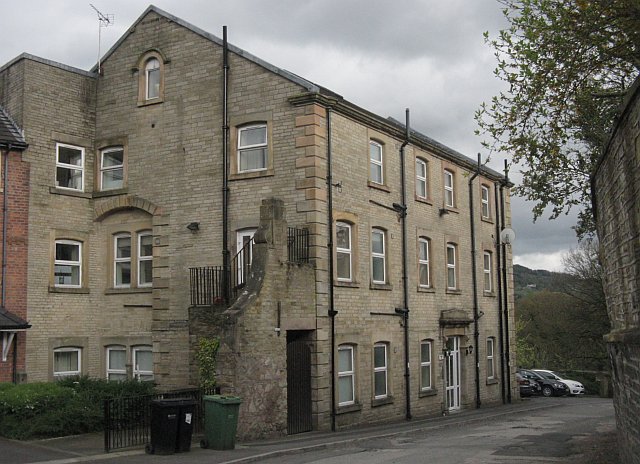
At the turn of the century, The domestic life of the family underwent some great changes. On 22 August 1901, he married Mary Anne Weild at St Peter's Church, Ealing, London. The decision had been made to find a new home, and the choice fell on 'Beechwood', a house in the rural outskirts of Marple, Cheshire which had previously been the home of Edward Ross J.P., Secretary of the Manchester, Sheffield and Lincolnshire, from 1850 to 1892. The house was clearly built for the railway company, as it stood (and still stands in 2017) on land which the company purchased when building the railway, opened in 1865 between Romiley and New Mills, through Marple South Tunnel which lies directly below the house. Although always shown on maps as 'Beechwood' , Mr Ross during his tenure appears to have referred to it as 'Rock Cottage'.
The 2017 photograph shows the house, now converted to flats. A curious feature was that the garden was across the road on a higher level, reached by a footbridge, the footings of which can still be seen.
James's son Frank Southern was educated at Manchester Grammar School and Manchester University where he gained a first-class honours degree in science. He became a Partner in the company, which became J.W.Southern & Son.
James Wilson Southern (Junior) emigrated to South Africa. A passenger list for 1890 shows a J.W. Southern embarking at Liverpool for Cape Town in 1890, and a J.W.Southern (junior) travelling there in 1899. He died there in 1901, probably of Tuberculosis.
George Cooper Southern (1877-1940) also emigrated to South Africa, and established himself as an Import Agent in Cape Town, and married in 1910 Barbara Cranston, who had been born in Otley, Yorkshire in 1881; she had emigrated with her windowed mother to South Africa after her father died in 1898.
Sadly, George lost all his money during the depression, and his son, J.W. Southern (III), was compelled to leave school and start work. He married an Afrikaner girl (Arnolda Elizabeth van Wyk) whose father had been a Boer commando her mother held in a British concentration camp from 1900-1902.
The son of James (III), also in turn named James, a great-grandson of the first James Wilson Southern, lives in the Cape Town area at the time of writing. He has inspired, and contributed significantly to, this feature.
A passenger list for the sailing from Southampton to Cape Town on 23 August 1935 of the Union Castle Line ship Winchester Castle tell us that George and his family returned to England a least once for a visit, as it includes G.C. Southern (age 57), Mrs B. Southern (age 32 - an error for 52?), their daughter Miss Nancy B.C. Southern (age 22) and their son Mr J.W. Southern (age 18). Their house in Cape Town was called 'Burnage' in memory of their former Manchester home.
Last days
Sadly, by 1906 James Wilson Southern (senior) was chronically ill, and was eventually confined to his bed. His achievements did not go unrecognised; in 1906 the council resolved to award him the ceremonial Freedom of the City, the highest honour the City can bestow. The presentation was delayed in the hope that he would recover, but eventually on 11 October 1907 a special deputation from the Council including the Lord Mayor, the Town Clerk and a number of Councillors, travelled to Knockbrex, Kirkudrightshire, the Scottish estate of his son-in-law James Brown, and 'in his sick-room the presentation was made, with all the ceremonial that the circumstances allowed.' Also present were members of the family and a few close friends. In the same year, 1907, at the recommendation of the Council, a Knighthood was conferred on him by the King, making him Sir James Southern.
He was back at 'Beechwood' when he died, never having fully recovered from his illness, on 9 January 1909. His funeral, at Manchester Crematorium preceded by a half-mile long procession from Didsbury, was attended by very many relatives, friends, and representatives from the organisations and firms with which he had been involved. His estate was valued at just over £10,000 - perhaps a million in present-day values, but a fraction of the amount left by textile magnates such as John Rylands.
His widow Mary Anne Southern, now, as the wife of a Knight, to be referred to as Lady Southern, left 'Beechwood'. The 1911 census shows her living at 'Longfield' in Heaton Norris with her daughter-in-law May. It seems she embarked on some foreign travels, as a newspaper report of 1913 records her being robbed of her jewellery and £600 after arrival at Ostend. In 1917 she sold a collection of 'solid silver goods and electro-plated goods' at a two-day auction in Manchester; she died on 28 June 1922 while staying in Smedley's Hydropathic Establishment, Matlock, Derbyshire.
Interesting in-laws
A few notes on the husbands of James Southern's daughters may be of interest.
Marion Southern married Alfred Woodroofe Fletcher, a son of Alfred J. Fletcher, General Manager of the Union Bank of Manchester, which in the 1920s merged with Barclays.
Woodroofe Fletcher, as he was generally known, studied law in Manchester, qualified as a Barrister, and was called to the Bar in 1893 as a member of the Middle Temple. By 1897 he was in practice in Manchester with his friend Harold Pilkington Turner. The two of them were involved in the setting up of the Ancoats Settlement, later known as the Manchester Settlement, set up by the University to reach out to the underprivileged of the district. His paper 'The Economic Results of the Ship Canal on Manchester and the Surrounding District', read to Manchester Statistical Society in February 1897 was much quoted in subsequent years. Woodroofe and Marion lived near Stockport, on Bramhall Lane South, Bramhall for a while.
In 1907 he gave up the profession to study for Holy Orders at Ripon Theological College. By the time of Sir James Southern's death he was serving as a Curate at St George's Church, Leeds. Yorkshire; In this capacity he greeted people coming to the funeral at Manchester Crematorium, and read an address during the service, on the life and work of Sir James. His brother Harold Fletcher was also present at the funeral.
The 1911 census finds him living with Marion and two servants in 'Ivyholme', 3 Princes Road, Ripon, Yorkshire, listed as 'Clergyman (Established Church). From 1912 he was Vicar of Hainton. Lincolnshire. During the First World War he served as an Army Chaplain. He was Vicar of Eckington, Worcestershire from 1920-32 where he wrote a book - Eckington. The story of a Worcestershire parish ... With adventures in illustration by the author -which was published by prestigious Oxford University Press in 1933. From 1932-44 he was the vicar of Repton, Derbyshire where he wrote the history of the church. Like his father-in-law, he was a supporter of free libraries and women's suffrage. He died in Alderney, Channel Islands on 20 November 1959, aged 91.
Eliza Mary Southern, known to her friends and family as May Southern, married James Brown (born 1840) of the well-known Manchester retail Affleck & Brown, which came to be known as the 'Harrods of the North'. James was born in Rochester, Kent, where his father John Brown had moved from Scotland to set up as a Draper and Tea Dealer before moving to Manchester where he initially walked round the surrounding villages carrying clothes for sale in a backpack. In 1860 John was offered by Robert Affleck a partnership in his drapery store in Oldham Street, Central Manchester. The business expanded over the years to become the large department store which many Manchester people will remember; when John Brown retired, his sons James and William Brown continued the work.
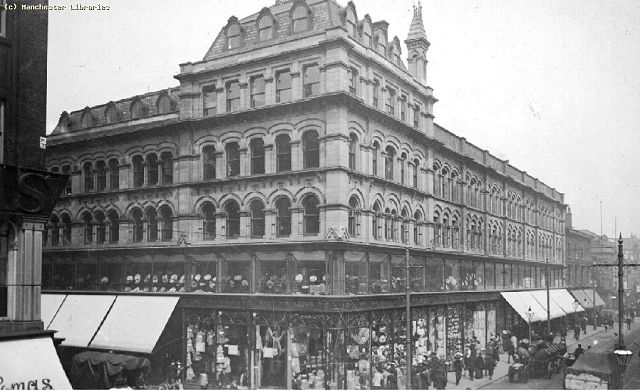
Affleck & Brown, c.1910 (Manchester Libraries)
James Brown and his family lived in a large house, built for them in around 1871 - named 'Longfield' after the farmhouse previously on the site - on Mauldeth Road, Heaton Mersey, north of Stockport. This remained their principal address, but with profits from the store he also purchased a house and estate, Knockbrex, in the Galloway area of Scotland, where James was able to develop his ideas on architecture and farming, no doubt with contributions from his wife. He re-designed and enlarged the original Knockbrex House in the 'Arts and Crafts' style of the time, and also created a farm dairy which became known as the 'Coo Palace' and a chapel for the village. The buildings were neglected in later years, but recently restoration work has been undertaken, in the cause of the chapel by a voluntary group, Kirkandrews Kirk Trustees including James and May's grand-daughter-in-law, Elizabeth Brown. A plaque in the grounds of the Kirk commemorates 'E. May Brown, born on 10 March 1870, and died in Mombassa 18 June 1941.' Another commemorates their son J. Douglas Brown.
James Brown died in 1920, and is buried outside his Kirkandrews Kirk. 'Longfield' passed to his brother William, and in 1929 it was sold to Stockport Education Committee to become Longfield Open Air School. According to the school's historian, this was:
... for children who suffered ill health in the town, mainly through smoke pollution. Pupils were bussed there before breakfast, from Portwood and other parts of the town. Most of them had a sleep outside in the afternoon so that they could take advantage of the clean air of Heaton Mersey. As the town became healthier and the chimneys stopped belching out black smoke, the need for an open air school lessened and it closed in 1968.The building was demolished and replaced by a new building which opened in 1970 as Tithe Barn Primary School which still thrives. A reminder of 'Longfield' survives in the shape of
A Venetian glass bathroom window which Mrs Brown had made to remind her of the beautiful water scenes in Venice. This glass panel was installed outside the Head Teacher’s office and is still there today.The original bath with its enamelled sides and copper shower canopy, along with some of the wooden panelling, was donated to the Castle Museum, York.
The Affleck and Brown store was taken over by the Debenhams Group in the 1950s, and closed in the 1970s when Debenham's moved into the former Paulden's store on in Market Street. The buildings which formed the store complex survive in various residential and trading uses.
Dorothy Southern married Scottish-born John Campbell Gray, Manager of the Strines Printworks of the Calico Printers Association, which was in the village of Strines not far from the Southerns' home in Marple. The wedding, a quiet affair as it was just weeks after her father's death, took place at Marple Bridge Congregational Church in April 1909. They lived in a large house named 'The Cottage' in Strines near the printworks; in 1911 they listed their baby daughter Dorothy Garland Gray and three domestic servants. John died in 1955. Their son Colin Campbell Gray, born in 1911, also continued in the textile printing business and was a director of a number of companies. He lived at Bradnor House, Hollingrove, above Todmorden in Lancashire, until his death in 1997.
Edith Isabel (known as Ella) Southern married James Dewsbury Chorlton (Born 1873) in 1902. He was the son of James Clayton Chorlton, a cotton merchant and manufacturer, who in 1911 purchased for his son the business of Charles Openshaw and Son, Fustian Merchants, of Todmorden, on the death of its former proprietor.
According to an interesting article by William Birch published in 2005 on the closing down of the company (which by then was part of a group engaged in the 'print consumables sector') in the Todmorden News:
J. D. Chorlton had graduated from Owen’s College (later Manchester University) with a BSc in mathematical physics and then studied law, gaining his LLB. He practised at the Bar, specialising in patents law. As well as publishing a book on the rating of land values he was also the author of several books on mathematical physics. Early in his career though, his hearing became severely impaired and he was compelled to bring it to an end.In fact he was a brilliant student, gaining a First Class Honours in physics in 1894 and in the same year he was elected the first Joule Scholar of the Royal Society, engaging in research in the College laboratories. In an interesting link with another Cassidy subject, James Prescott Joule, he published a paper in the Proceedings of the Royal Society (Vol.49, 1896, p. 345-359) entitled 'Report on the Examination of some of the Scientific Instruments Employed by the late Dr. Joule'. He was awarded the degree of M.Sc in 1897, but by this time this was published, he had already embarked on a new career, being 'Called to the Bar' at the Middle Temple in London where he was residing at the time of the 1901 Census. In a later article, William Birch writes that
Mr J. D. Chorlton continued to trade under the long-established Openshaw name and some years later moved premises to offices in Gartside Street in Salford and a nearby large warehouse directly above the LMS Railway Goods Station.
'In his early life Mr Chorlton had been a keen horseman, golfer, hiker and mountain climber and had travelled widely in Europe and both North and South America.'
The air raids in 1940 destroyed the Gartside Street premises, and the company found premises Todmorden. J.D. Chorlton remained Chairman of the Board of Directors until 1966 when he retired, aged 93, dying two years later. His place was taken by Colin Campbell Gray, the son of Ella's sister Dorothy (see above). In the 1970s the company was sold to an international group.
James and Ella, who lived in Palatine Road, Didsbury, had just two children, both girls, Elizabeth and Dorothy, who both died while in their 20s. Ella Died in 1960.
The Next Generations
Although well-removed from James Wilson Southern's life, we cannot resist including some stories of his grandchildren as related to use by family members who have written to us in response to this feature.
James Douglas Brown, son of James Brown and May Southern, took over from his father as the owner of the Manchester store. He married Lorraine Sandow, the younger daughter of Eugen Sandow, a man who was a world famous household name in his day as a performing strongman and proponent of physical culture. She had pretensions to be an actress, and like other showgirls who married millionaire businessmen - such as Gabrielle Ray and Lily Elsie - it appears that after a while she did not enjoy her married life, described by Sandow biographer David Waller as 'shooting parties, bathing expeditions from the private beach, boat trips on the family's steamboat and a house full of guests all summer long.' Lorraine's mother Blanche was the daughter (and assistant) of Warwick Brookes (1832-1929) a pioneering photographer who had premises at 350 Oxford Road, Manchester.
After bearing two children with Mr Brown, she left, having fallen in love with young undergraduate, Nugent Davidson, who had been invited to the Knockbrex mansion for the summer to help with the rose garden. He was the son of Harold Davidson, notorious as the 'Rector of Stiffkey' who was accused of immoral activities in a great scandal of the 1930s. It is said that she was never spoken again in the Brown household. The Brown faimly was left to care for the two baby daughters, one of whom, Ann, is the great-aunt of David Waller whose book on Sandow, The Perfect Man, is a fascinating read.
Isobel Mary Brown, (known as Iso) daughter of James Brown and May Southern, was born in Heaton Mersey in 1902, she was educated as a boarder at Bilton Grange Preparatory school in Warwickshire, where she appears in the 1911 Census, aged 9. She married Ross Douglas Waller (1899-1988). A historian, he was appointed in 1937 as Director of Extra-Mural Studies, under the auspices of The University of Manchester, and presided over the creation of residential colleges for adult learners, first in an old house 'Denzell' in Bowdon and later at Holly Royde in Withington.
The Department of Adult Education was set up in 1949 within the University's Faculty of Education. Its purpose was to teach and research the theory and practice of adult education. The Department was the first of its kind in the UK. Ross Waller was appointed its first professor and head of department, serving until 1965. Sadly, since the 1980s the University has mostly withdrawn from the extra-mural course which were enjoyed by many, and Holly Royde College closed in the 1990s. Professor Waller received the CBE in honour of his work.
We understand that it was the Waller family who loaned, and later donated, the bust and scroll to the Museum.
In 1973, 'Iso' made news when she came to the attention of Bowdon Urban District Council by allowing a homeless family to live in the cellars of her house at 3 Church Bank, Richmond Road, Bowdon, near Altrincham. It was stated that the accommodation was not up to the required standard and did not have a toilet, although it did have 'large windows,a private Roman Catholic chapel and a bathroom in a converted coal hole' and refugees and air-raid wardens had stayed there during the war. Many of the guests, 79 of them over the years from 1957 onwards, were unmarried mothers from Ireland, according to local author Alice Frank who includes tales of real-life Mrs Waller in her historical novel A Bowdon Romance set in the area.
Our correspondents who in their younger days visited 'Aunt Iso' remember her as an eccentric character; she died in 1989 and her house has been replaced by a block of flats built in a sympathetic style.
Derwentwater - a sonnet, by James Wilson Southern
Fair Derwentwater, Neither poet's pen
Nor painter's pencil can pourtray thy charms
Whether when sleeping in the peaceful arms
Of Summer's purple eventide, or when
Evening dissolves in moonlight night,- for then
The soft light mellows and the breeze embalms
The rippling wave, and thy still beauty calms
Man's troubled breast, from mountain, stream and glen
Nature's harmonious voice speaks peace; nor less
Thy beauty when at early morn thy face
Reflects the rosy sky, the towering hill,
The waking hamlet; and the loneliness
Of night, and silence to the stir gives place
Of cheerful day, and movement audible.
Southerns visit Manchester, 2016
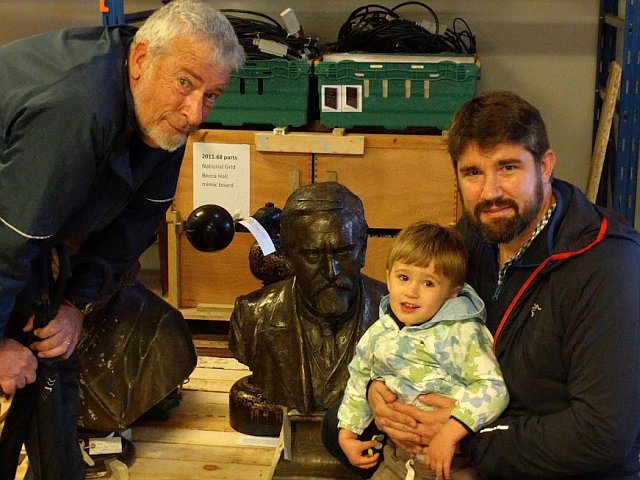
In August 2016 we were pleased to accompany a Southern family group on a tour of Manchester, including a visit to the Museum exhibits no longer on public display. Above: James Southern of Cape Town, grandson of Sir James; his son James, now residing in the USA; and his son, also a James Southern.
Compiled by Charlie Hulme, last update December 2017.
Comments welcome at charlie@johncassidy.org.uk